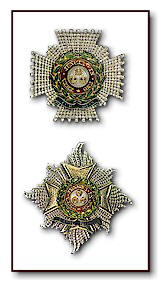|
|||||||
| 1104 'PIPS'
The only officer ranks in these two armies that do not contain a pip are those of major, lieutenant general and field marshal. These ranks utilize a crown rather than pips.
Although some regiments in the
British Army have used their own version of the
pip, the general issue pip and the one used
in the Australian Army is a stylized version of
the very elaborate
star of the Knight Grand Cross of the military
division of the Most Honourable Order of the Bath,
one of Great Britain's four senior orders of
knighthood. (The others being the Order of the
Garter, the Order of the Thistle and the Order of
Saint Patrick.) The original badge contains the motto "Tria Juncta in Uno", which means "Three Joined in One", and refers to the union of the three kingdoms of the British Isles (England/Wales, Scotland and Ireland). If you have an older metal Australian pip, you might be able to make out the motto. As far as I can discover, in WW1 there were 2nd lieutenants in the Australian Army, as one might expect, but in WW2 there were none, the rank existing in theory only, as all lieutenants were 1st lieutenants with two pips. Why this was so, I have not yet been able to find out. Perhaps someone out there knows. Share your knowledge with us.
|
|||||||
|


